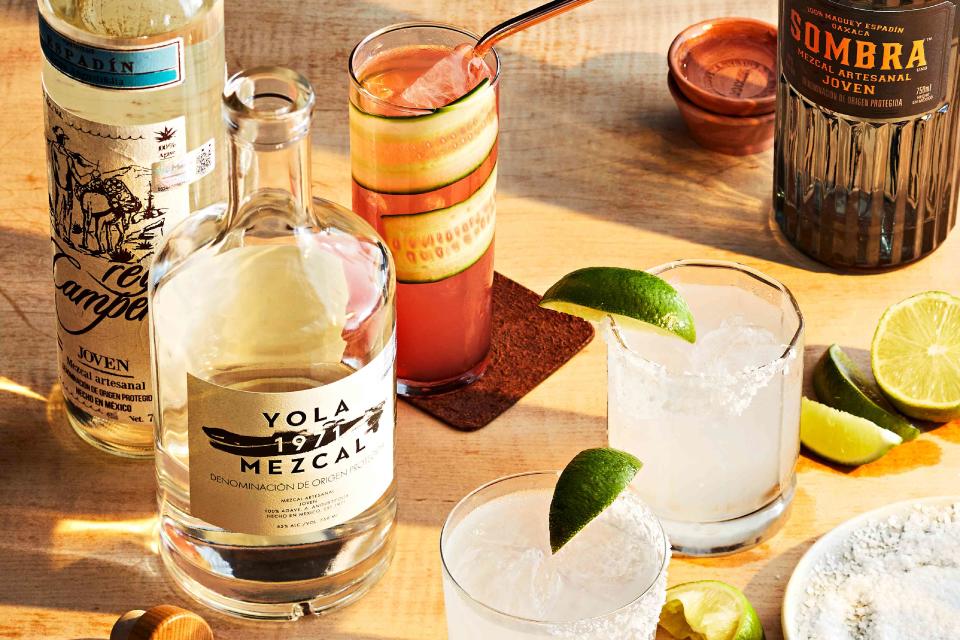Why This One Piece of Information is the Most Important Thing on Your Bottle of Mezcal
Making better mezcal cocktails starts with reading the bottle a little more closely.

Victor Protasio / Food Styling by Margaret Monroe Dickey / Prop Styling by Christine Keely
For all the brands of tequila on the market right now, the basics of the category are relatively straightforward, especially when it comes to the raw materials that the spirits are based on: By law, tequila can only be produced from the Blue Weber agave — full stop. With mezcal, however, that rule doesn’t apply: There are many different types of agave that the great spirit can be crafted from. This is where the confusion starts seeping in, since the intersection of agave variety, micro-climate, terroir, and production decisions all play a role in the final liquid in the glass. Yet according to some experts, few things matter more than the agave itself, and where it’s grown.
“The choice of agave variety is as crucial to crafting mezcal as selecting the main ingredient in any recipe,” explains Isabel Santiago, maestra mezcalera of ZOMOZ. “Each type of agave possesses its unique characteristics, heavily influenced by the region in which they are grown, resulting in distinct flavor profiles. For instance, Cuishe imparts herbal notes, while Tobalá offers a mineral and earthy flavor. Mexicano agaves tend to have a sweeter profile, while Tepeztate is a medley of both flavors. On the other hand, cultivated agaves like Espadín provide a more neutral base, enabling mezcal producers to create diverse flavor profiles through their processing methods.”
Related: What's the Difference Between Tequila and Mezcal?
Sydney Block, co-founder of Catedral de Mi Padre Mezcal, agrees. “The type of agave is very important to the taste of the finished mezcal — it is one of the differentiating factors between mezcal and tequila. In mezcal, there are many different types of agave used, which all impart a unique flavor profile. Additionally, the terroir of the environment also impacts the flavor profile of each agave as altitude, soil type and other vegetation can add nuances of flavor, similar to grapes and wine.”
August Sebastiani, founder and president of 3 Badge, which produces Bozal Mezcal, likens the interplay between agave and terroir to the ways in which grape variety and vineyard characteristics affect one another. “Each agave is unique in flavor profile and taste,” he notes. “And having come of age in wine, it’s fascinating to see the parallels between agave and wine grapes. For instance, there can be a significant amount of terroir influence whether it be more minerality, fruit, or vegetal notes. The variety of agave itself also has common descriptors that you can find among various mezcals.”
Other experts find similarities between certain types of mezcal and the world of whisky. Tepeztate-based mezcals, believes Jordan Haddad, managing partner of La Tierra de Acre Mezcal, are of particular note…though finding them can require some legwork. “While there is limited supply (due to the average agave plant maturing between 25 to 30 years) consumers are seeking unique mezcal experiences similar to single malts.” Within La Tierra de Acre’s own portfolio, a side-by-side tasting of their Cenizo and Espadín expressions provides remarkable insight into the differences between the various agaves: The former is more taut, mineral, and spicy, whereas the latter is more fruit-driven and lifted.
Related: 13 Mezcal Cocktails Our Editors Love
Then there are mezcals that have terminology on the label that has nothing to do with the type of agave used. Del Maguey, for example, famously highlights individual villages. Fósforo Mezcal has an expression that’s labeled both with the agave variety (Tobalá) as well as the word “penca,” which indicates that it’s been aged (in this case for three months) with a cooked agave leaf. Bosscal has an expression called Conejo, whose vapors from the third distillation passed through a rabbit breast, which in turn flavored the liquid. Bozal recently released a bottle called Cempasúchil that was distilled with marigolds.
For now, however, it’s the variety of agave that is getting much of the attention, and with good reason: They are a great point of entry for exploring all that this incredible spirit has to offer.
For more Food & Wine news, make sure to sign up for our newsletter!
Read the original article on Food & Wine.

